Short-term and Long-term Rental Strategies
Key Learning Objectives:
Introduction: This section introduces the intricacies of short-term and long-term rental strategies in real estate. By contrasting the two, investors can discern which approach best aligns with their goals.
- Acquire a thorough understanding of the distinct dynamics between short-term and long-term rentals, as well as their alignment with various investment objectives and market scenarios.
- Understand the potential benefits and challenges associated with short-term rentals, including the allure of high cash flow and the nuances of seasonality.
- Delve into the stability and passive income possibilities of long-term rentals, alongside challenges such as prolonged vacancies and heightened competition.
- Recognize the pivotal role of local regulations in shaping rental strategies and the imperative of adherence for successful real estate investment.
Real estate investors often choose between short-term and long-term rental strategies based on their investment goals, risk tolerance, and desired level of involvement. This section will discuss these two rental strategies and their respective pros and cons.
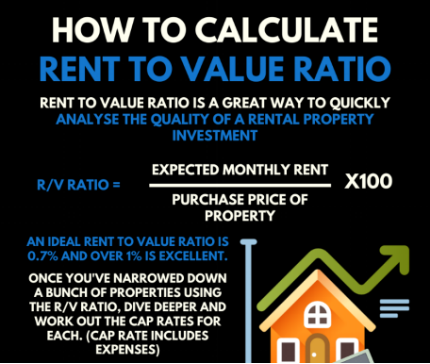
Figure: This infographic explains how to calculate the “Rent to Value Ratio,” a key metric in evaluating the quality of a rental property investment. It describes the formula as the expected monthly rent divided by the purchase price of the property, multiplied by 100. The infographic suggests that an ideal Rent to Value Ratio is 0.7% and anything over 1% is excellent. It advises that once a list of properties is narrowed down using this ratio, investors should further analyze the properties by calculating their capitalization rates, which include expenses. This information is crucial for real estate investors, providing a straightforward method to assess potential rental properties quickly and efficiently.
Source: Custom Infographic
A. Short-term Rentals
Description: The short-term rental strategy involves renting out a property for a short period of time, typically on a nightly or weekly basis. This strategy is popular for properties located in tourist destinations or urban areas with high demand for short-term lodging.
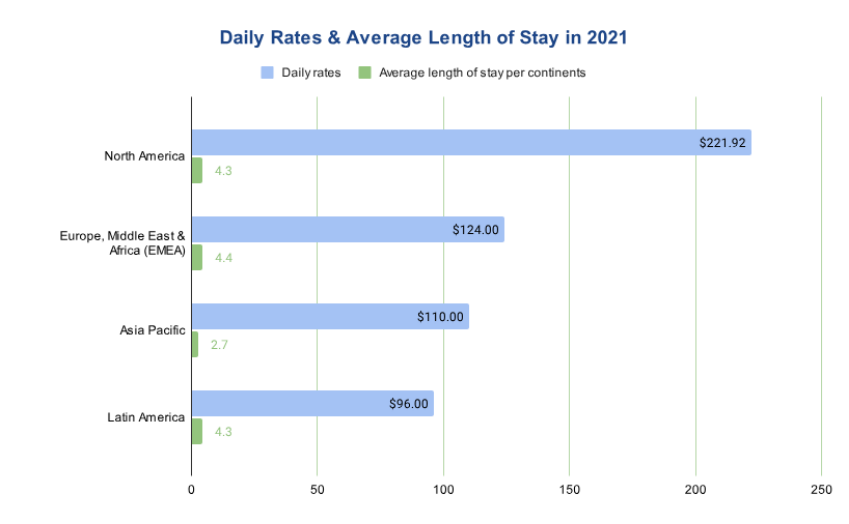
Figure title: Daily Rates and Average Length of Stay in 2021
Source: Airbtics:
Description: This image likely presents a visual representation of data related to daily rates and the average length of stay for Airbnb properties in 2021. The data visualization aims to provide valuable insights into the short-term rental market for Airbnb hosts and investors.
Key takeaways:
- Data Visualization: The image presents data in a visual format, making it easier for viewers to grasp trends and patterns.
- Daily Rates: It likely includes information on the average daily rates for Airbnb properties, indicating pricing trends.
- Average Length of Stay: The image may also depict the average length of stay for guests, revealing insights into guest behavior and preferences.
- Market Insights: This data can be invaluable for Airbnb hosts and investors in making pricing and investment decisions.
Application: Real estate investors, especially those involved in short-term rentals or Airbnb hosting, can use this image to gain insights into market trends. It can be employed in presentations, reports, or articles discussing the short-term rental market and pricing strategies. Additionally, educators and consultants in the real estate and hospitality industries can utilize this visual to educate their audience about the dynamics of the Airbnb market.
Pros:
- High cash flow: Short-term rentals can command higher rental rates than long-term rentals, providing the potential for high cash flow.
- Higher occupancy rates: High demand for short-term rentals can result in higher occupancy rates, leading to more consistent rental income.
Cons:
- Seasonality: Demand for short-term rentals can vary seasonally, potentially leading to fluctuations in rental income.
- Competition: The popularity of short-term rentals has led to increased competition from other property owners and online platforms such as Airbnb.
Legal and Regulatory Considerations: Short-term rentals are subject to location-specific regulations, including licensing requirements, occupancy limits, and zoning restrictions. Researching and complying with local regulations is crucial to avoid legal issues and fines.
Best Practices/Advice: Research local regulations, accurately estimate rental income and expenses, and have a solid understanding of the local real estate market and economic conditions before implementing this strategy.
B. Long-term Rentals
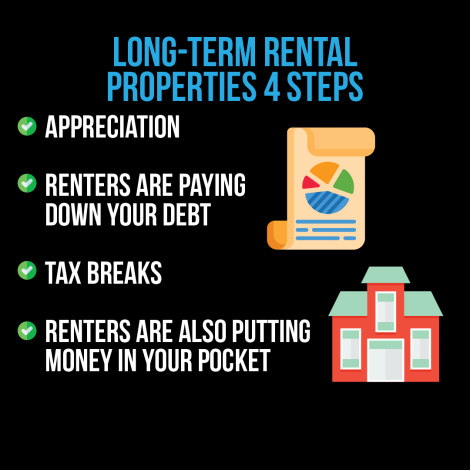
Figure: This infographic outlines the benefits of long-term rental properties in four key steps: appreciation of property value over time, renters contributing to mortgage payments, tax breaks associated with rental properties, and the generation of regular income from rent payments. It emphasizes the dual advantage of building equity while earning rental income, making it a compelling option for real estate investors. This information is particularly valuable for those considering investing in rental properties, highlighting the financial gains and stability that can be achieved through long-term rentals.
Source: Custom Infographic
Description: The long-term rental strategy involves renting out a property for a long period of time, typically six months to a year or more. This strategy is popular for properties located in residential areas with a high demand for long-term rentals.
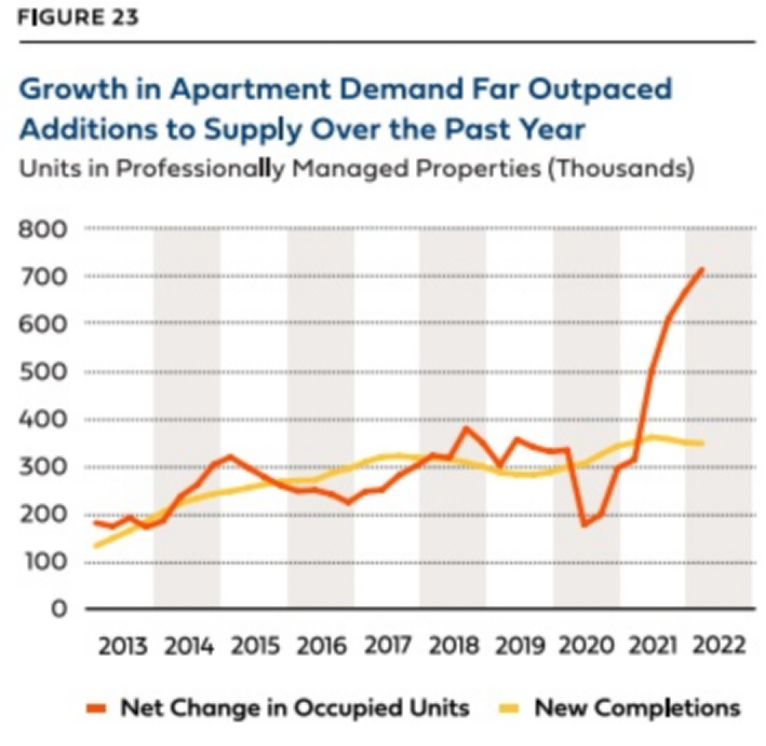
Figure title: Demand vs. Supply in Rental Housing
Source: ManageCasa:
Description: The image likely presents a visual representation of the relationship between demand and supply in the rental housing market in the United States. It may include graphs, charts, or infographics that illustrate trends, fluctuations, and the balance between the demand for rental properties and the supply of available units. This visual aims to provide valuable insights into the dynamics of the rental property market.
Key takeaways:
- Data Visualization: The image presents data in a visual format, facilitating an understanding of demand and supply dynamics.
- Demand Trends: It likely showcases patterns in rental property demand, such as seasonal fluctuations or long-term trends.
- Supply Insights: The image may also depict variations in the supply of rental housing, including factors that impact availability.
- Market Analysis: This data can be useful for property managers, landlords, and real estate investors seeking to make informed decisions about rental properties.
Application: Real estate professionals, property managers, investors, and educators can use this image to gain insights into the rental property market’s dynamics. It can be integrated into presentations, reports, or articles discussing the state of the rental housing market in the United States. Additionally, it serves as a valuable educational tool for those studying or teaching about real estate and property management.
Pros:
- Stable cash flow: Long-term rentals provide a reliable source of income, as renters typically sign leases for extended periods of time.
- Passive income: Long-term rentals can offer a consistent source of passive income, requiring minimal effort from the investor.
Cons:
- Vacancy risk: Long-term rentals can experience periods of vacancy, resulting in lost rental income and additional expenses for finding new tenants.
- Competition: The popularity of long-term rentals has led to increased competition from other property owners and rental companies.
Legal and Regulatory Considerations: Long-term rentals are subject to location-specific regulations, including requirements for rental licenses and inspections. Researching and complying with local regulations is crucial to avoid legal issues and fines.
Best Practices/Advice: Conduct due diligence, accurately estimate rental income and expenses, and have a solid understanding of the local real estate market and economic conditions before implementing this strategy.
Figure: This infographic explains why rental properties are profitable investments. It highlights four key aspects: Cash Flow, where rental properties provide a steady stream of income; Appreciation, allowing investors to sell their properties for a profit after holding them for years; Tax Benefits/Deductions, offering financial advantages from owning rental property; and Hedge Against Inflation, enabling investors to rent out or sell their properties at higher prices due to inflation. This information is crucial for real estate investors, providing a clear understanding of the various financial benefits associated with rental properties.
Source: Custom Infographic
In conclusion, both short-term and long-term rental strategies have their pros and cons. Investors should carefully consider their goals, risk tolerance, and desired level of involvement before choosing a rental strategy. Additionally, it’s crucial to research local regulations, accurately estimate rental income and expenses, and have a solid understanding of the local real estate market and economic conditions to make informed decisions and optimize returns.
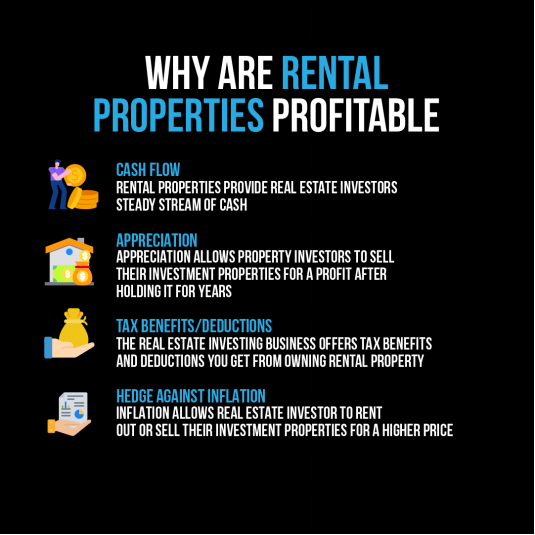
Key Takeaways:
Closing Statement: Mastering the realm of rental strategies is vital for astute real estate investment. In summary:
- Short-term rentals can offer high returns, but they come with the challenges of seasonality and a saturated market.
- Long-term rentals promise steady income and can be less hands-on, but they require effective tenant and vacancy management.
- In both strategies, understanding and complying with local regulations is not just essential—it’s non-negotiable.

